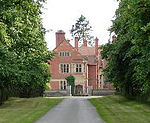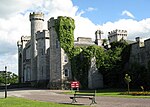Bedd-y-Cawr Hillfort
Hillforts in DenbighshireScheduled monuments in Denbighshire

Bedd-y-Cawr Hillfort, or Bedd y Cawr Hillfort, is an Iron Age hillfort on a natural inland promontory in the community of Cefnmeiriadog in Denbighshire in North Wales. The name of the hillfort translates from the Welsh as Giant's Tomb. Bedd-y-Cawr Hillfort is a scheduled monument that lies approximately 3.3 kilometres (2.1 miles) west of St Asaph and 4.0 kilometres (2.5 miles) north of Henllan.
Excerpt from the Wikipedia article Bedd-y-Cawr Hillfort (License: CC BY-SA 3.0, Authors, Images).Bedd-y-Cawr Hillfort
Maes Robert,
Geographical coordinates (GPS) Address External links Nearby Places Show on map
Geographical coordinates (GPS)
| Latitude | Longitude |
|---|---|
| N 53.2363 ° | E -3.4799 ° |
Address
Bedd-y-cawr Hillfort
Maes Robert
LL17 0HR , Cefnmeiriadog
Wales, United Kingdom
Open on Google Maps









